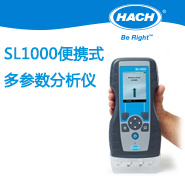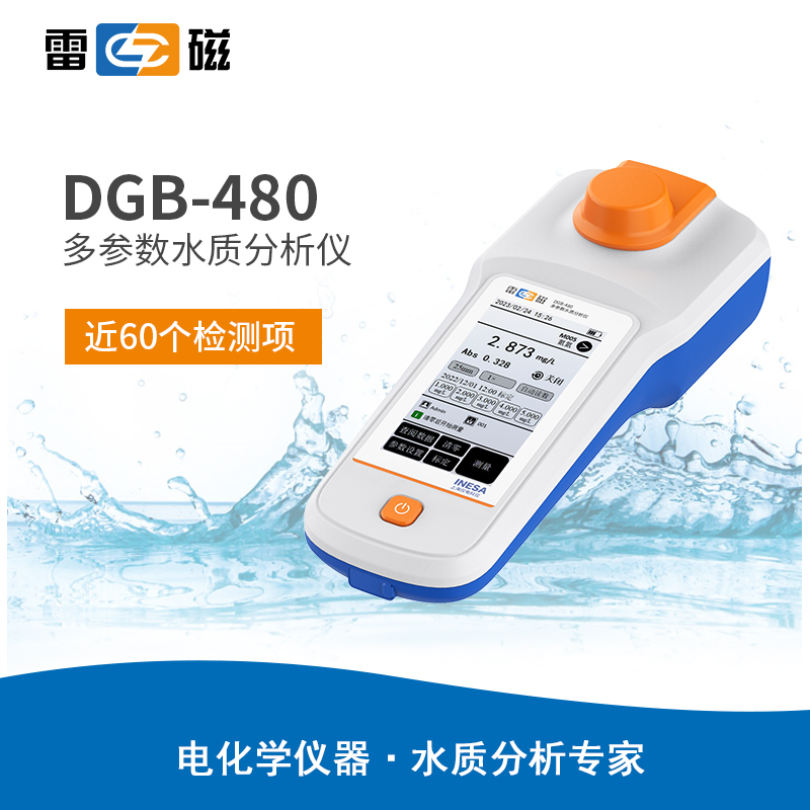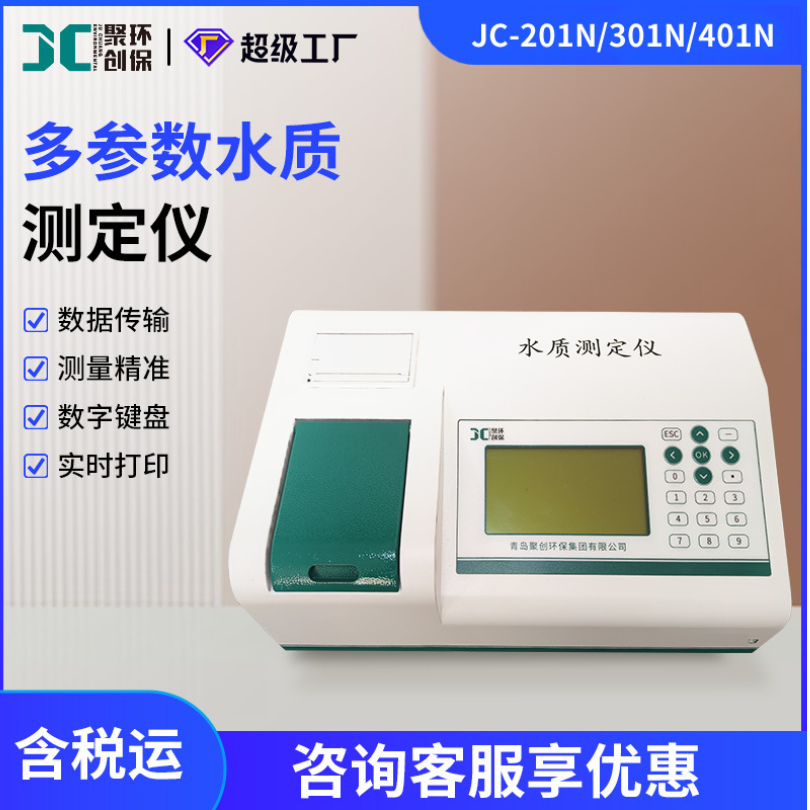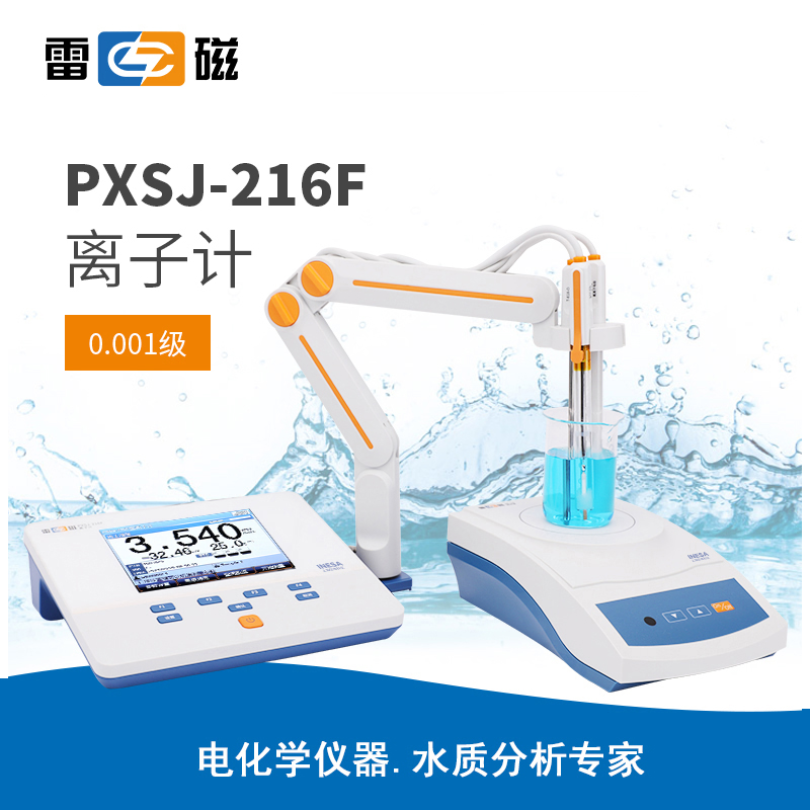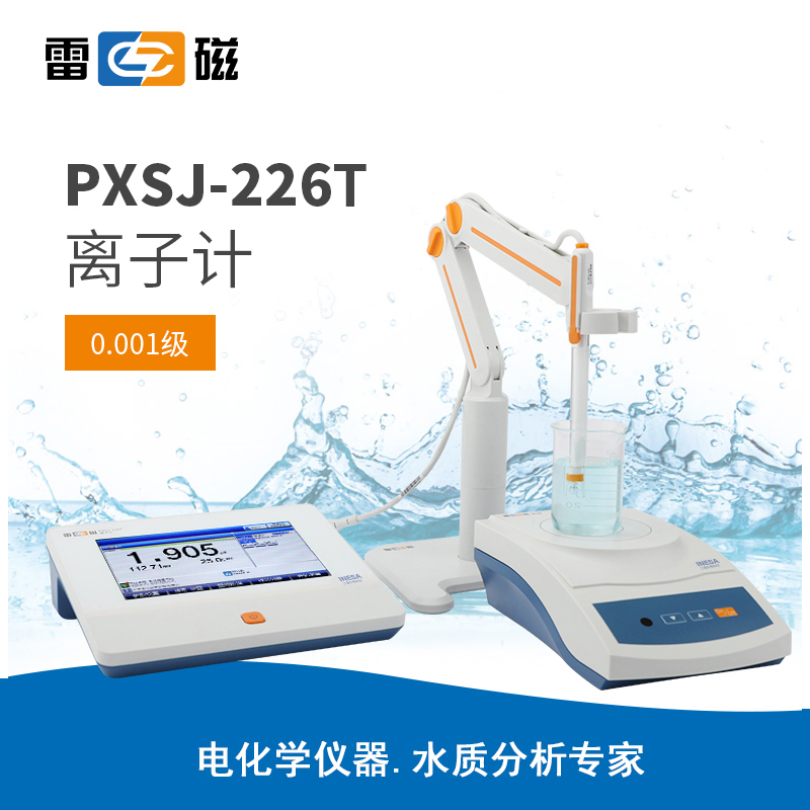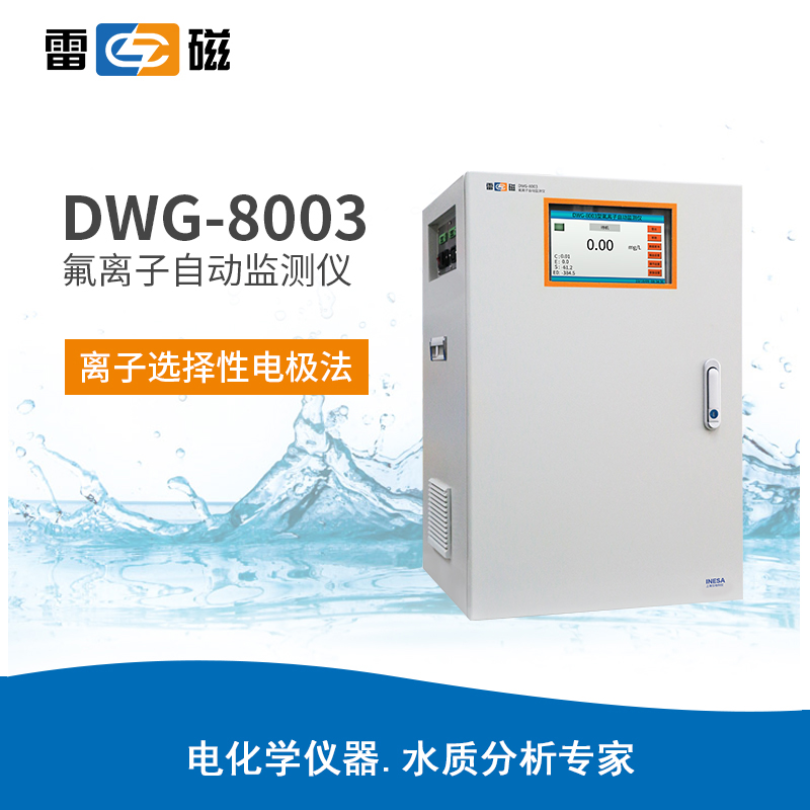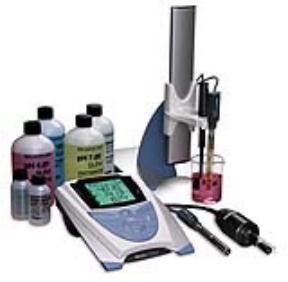
方案详情
文
本文章详细介绍了饮用水中硫离子的测定,包括校准液、水样的准备,校准和测量过程,以及电极和仪表的维护等内容。
方案详情

Sulfide inDrinking Water Sulfde inDrinking Water Calibration and Analysis 1. Allow all the standards and the samples to attain room temperature for precise measurements since themeasurement is temperature sensitive. 2.Calibrate the meter using the 0.1 followed by the 1.0 ppm standard, stirring the standards at auniform rate. 3. Immerse electrode in beaker with 0.1 ppm S-standard. Press the CALIBRATION key. 4.Wait for stable reading (1-2 minutes). Enter 0.1 using scroll keys. 5. Press the CALIBRATION key to the accept 0.1 ppm standard. 6.Immerse electrode in beaker with 1.0 ppm S-standard. 7.Wait for stable reading (1-2 minutes). Enter 1.0 using scroll keys. 8. Press the MEASURE key to accept 1.0 % standard and move measure mode. 9. Immerse electrode in prepared sample. Wait for reading. Rinse electrode between measurements. 10. Measure samples, stirring at the same uniform rate used for calibrating the standards, and rinsingelectrodes in deionized water between measurements. 11. Rinse electrode with deionized water. Shake after rinsing to prevent solution carry-over. Do not wipeor rub the sensing element. Place the probes and stirrer in a prepared sample such that the electrodetip is fully immersed in the solution. Press the MEASURE key on the meter; the stirrer will turn on.The ISE: mg/L icon will flash as the measurement is being made. The ISE:mg/L icon will becomesolid and the display value will freeze when a stable reading is achieved. This value is logged andprinted automatically and the stirrer turns off automatically. 12. Repeat steps 10 and 11 for additional samples. Remember to rinse the electrodes with deionized waterbetween measurements. Insert the electrode to the same depth to reproduce sample measurement.Upon completion of samples, rinse the electrode with deionized water and store the electrodeaccording to instructions in the Electrode Storage section of this method note. ROSS and the COIL tradedress are trademarks ofThermo Electron Corporation. U.S. Patent 6,793,787 Sulfide inDrinkingWater Introduction This method measures sulfide ion directly in drinking water. The direct measurement of sulfide ion withthe silver/sulfide electrode is a well-established technique that is frequently used as a standard method ofanalysis. The ion-selective electrode measures sulfide ions in aqueous solutions quickly, simply, accurately,and economically. Recommended Equipment Cat. No. Sulfide Application Package (includes all items with a catalog no) 1010107 1. 4-Star benchtop pH/ISE meter 1115000 2. Orion ionplus° Combination Silver/Sulfide electrode 9616BNWP 3.Be1nchtop stirrer (or magnetic stir plate and bar) 096019 4. Benchtop electrode stand 1110001 5. Beakers (50 mL) 6. Graduated cylinder (50 mL) 7. Pipette (10 mL) 8.Volumetric flask (1L) .Burette (25mL) Required SolutionsCat.No.1. Sulfide Anti-Oxidant Buffer (SAOB II) Reagent Pack9416092. Reference Filling Solution, Optimum Results"A9000613. Sulfide Standard, 100 ppm as S,Customer prepared4. Sodium Sulfide (Na,S*9H,O)Reagent grade5. Deionized water6. Optional Solution Lead Perchlorate Solution (0.1 M)948206* (Not Included) Calibration Standard Preparation 1. To prepare a stock solution of saturated sodium sulfide, dissolve approximately 100 g of reagent-gradeNa,S*9H,O in 100 mL deionized, de-aerated water. Shake well and let stand overnight. Store in atightly sealed bottle in a hood. 2.To prepare a sulfide standard weekly,pipette 10 mL of the stock into 1 L volumetric flask. Add 500 mL SAOB II and dilute to volume with deionized, de-aerated water. Determine the exact concentration, C, by titrating 10 mL of the standard with 0.1 M lead perchlorate, using the electrode as the end point indicator, and calculate: C=3206(Vt/Vs) where: C=concentration as ppm sulfide Vt = volume of titrant at end point Vs=volume of standard (10 mL) 3. Prepare 0.1 ppm and 1.0 ppm standards daily by serial dilution of the weekly standard. 4 Using a graduated cylinder, transfer 25 mL of the 0.1 ppm standard into a beaker. Add 25 mL of SAOB II. Add a magnetic stir bar to the beaker. 5. Using a graduated cylinder, transfer 25 mL of the 1.0 ppm standard into a beaker. Add 25 mL of SAOB I.6 The actual concentration of the standards prepared is half the stated value. All samples will be dilutedthe same manner with SAOB. Since the standards and samples will be treated in the same manner, nocorrection will be needed. Sample Preparation 1. Using a graduated cylinder, measure 25 mL of the sample into a beaker. Add 25 mL of SAOB II. .22. Repeat this procedure for additional measurements. Results Five aliquots of drinking water collected from a faucet were measured for sulfide presence. The resultsdemonstrate that the sulfide level in drinking water was less than 0.10ppm. A sulfide spike sample was analyzedto determine effect of the sample matrix on the accuracy of the analytical results. The analyte spike recovery was102.4%. Drinking Water ppm (mg/L) Sulfide Sample #1: <0.10 Sample # 2: <0.10 Sample#3: <0.10 Sample # 4: <0.10 Sample #5: <0.10 Electrode Storage The solution in the Orion 9616 Combination Silver/Sulfide electrode should not be allowed to evaporate,causing crystallization. For a short period of time (up to one week), store the electrode in deionized water. Forstorage longer than one week, drain the electrode, flush the inside with deionized water and store dry with thecap on to protect the sensing element. Equipment Setup Electrode Setup -ROSS Sure-Flow° 1. Remove the rubber cap covering the electrode tip. Fill outer chamber with Optimum Result A filling solution. Lift the spout to a vertical position. 4. Insert the spout into the filling hole in the outer sleeve and add a small amount of filling solution to thechamber. Tip the electrode to moisten the o-ring at the top and return electrode to a vertical position. 5. Holding the electrode by the barrel with one hand, use the thumb to push down on the electrode cap, allowing a few drops of filling solution to drain wetting the inner cone. .6 Release sleeve. If sleeve does not return to its original position immediately, check to see if the o-ring ismoist enough and repeat steps 4-6 until the sleeve has returned to original position. Add filling solution upto the filling hole. Meter Setup-4 star For initial meter setup, follow the steps on the Quick Reference Guide that is attached to the meter itself.The Quick-Start Guide also contains a layout of the meter keypad for reference. The words in this methodrepresented in all capital letters, such as POWER, indicate a key on the meter, and words in quotations such as“Unit"indicate information on the meter display. 1.Connect the electrode to the meter. 2. Press the POWER key on the meter to turn the meter on. 3. Note that the arrow on the left of the screen indicates the active line. If the top line is not active, press theLINE SELECTION key to change the selected line to the top line. 4. Press the SETUP key. Use the UP or DOWN keys to enter ISE Setup. Press the LINE SELECTIONkey toc s.el.ect the bottom line. Press the UP or DOWN arrow keys to select“2”for “rES" which is anabbreviation for resolution or number of significant digits. Press the LINE SELECTION key to acceptsetting. .5 Press the LINE SELECTION key to select the middle line, and press the DOWN arrow key to select “nLIn" which is an abbreviation for non-linear blank correction. 6 Press the LINE SELECTION key to select the bottom line. Press UP or DOWN arrow keys to select“off”for“nL In”. Press the LINE SELECT key to accept setting. 7. Press the LINE SELECTION key to select middle line, and press the DOWN arrow key to select "rAng”which is an abbreviation for measurement range. 8 Press the LINE SELECTION key to select the bottom line. Press the UP or DOWN arrow keys to select“HigH”for“rAng”. Press the LINE SELECT key to accept setting. 9.Press the LINE SELECTION key to select middle line, and press the DOWN arrow key to select“Unit".10. Press the LINE SELECTION key to select the bottom line. Press the UP or DOWN arrow keys to select “mgL”for “Unit". Press the LINE SELECTION key to accept setting. 11. Press the MEASURE key to return to the measurement mode. If all steps were followed correctly the meter display will show two digits in the top line and“ISE: mg/L"to theright of the top line. The meter and electrode are now ready for calibration. Note: The Orion Benchtop Stirrer must be turned on in General Instrument setup before analysis,please see the Quickstart guide for instructions. of ofof
确定

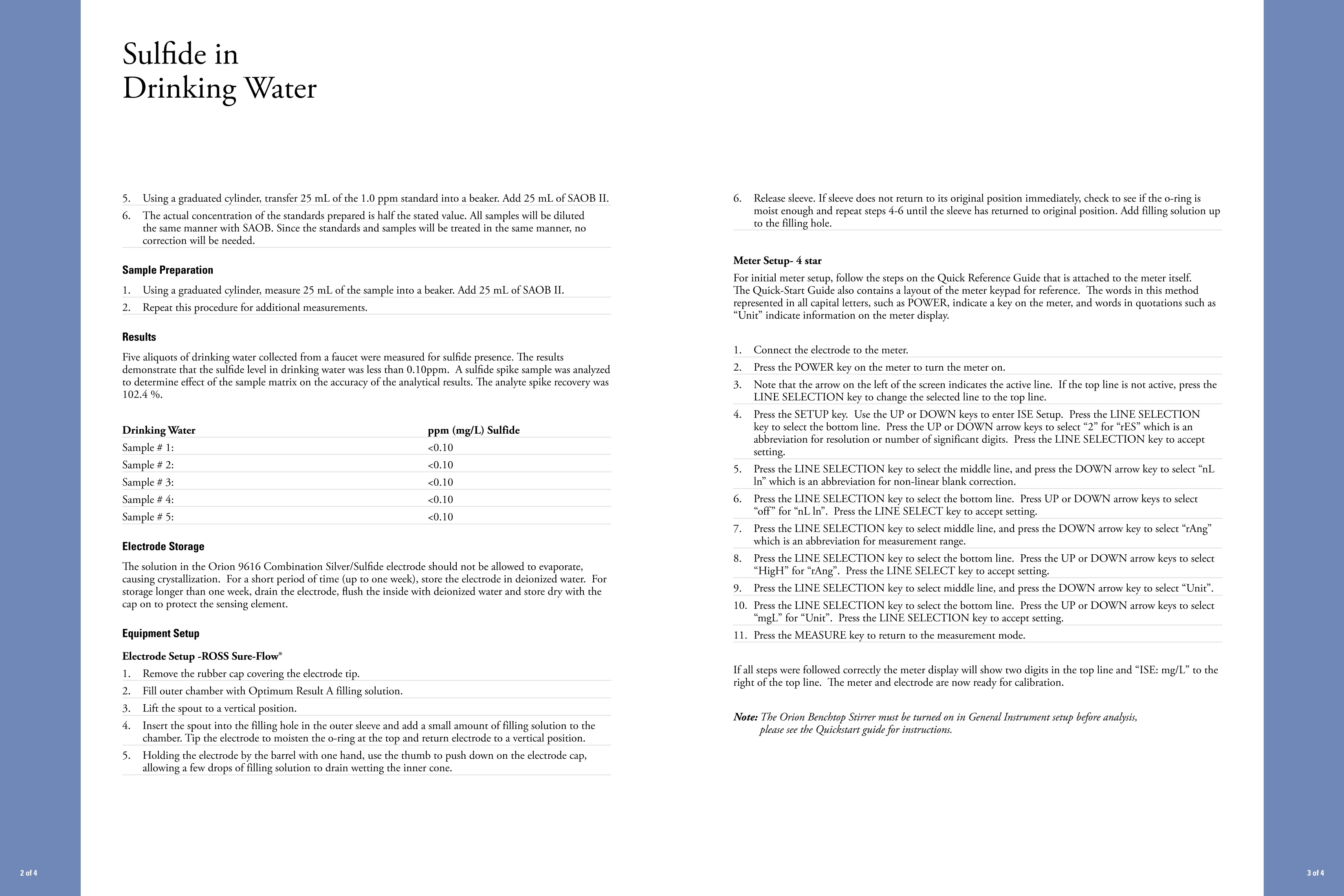
还剩1页未读,是否继续阅读?
赛默飞中国实验室产品事业部为您提供《饮用水中无机阴离子检测方案 》,该方案主要用于饮用水中无机阴离子检测,参考标准--,《饮用水中无机阴离子检测方案 》用到的仪器有台式pH/ORP/ISE/溶解氧/电导率测量仪、Orion 4-Star台式(便携式)pH/离子浓度测量仪
推荐专场
该厂商其他方案
更多











